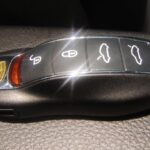The Warn EVO 10s winch is a popular choice for off-road enthusiasts, and the wireless remote option offers added convenience. After installing my Warn EVO 10s, I opted for the wireless remote upgrade, taking advantage of a credit from Warn due to a recall on their wired remote. The wireless system, controlled via a smartphone app over Bluetooth, seemed like a great addition. The initial setup process, or “programming” as some might call it, is undeniably straightforward. You simply plug the receiver into the winch, activate Bluetooth on the receiver by holding a button, and then pair it with the Warn app on your phone. The app itself is user-friendly and intuitive, making this initial programming phase quite simple.
 Warn winch app interface showcasing control buttons
Warn winch app interface showcasing control buttons
However, the ease of initial programming doesn’t tell the whole story. A significant design oversight becomes apparent with prolonged use, particularly for those who, like me, don’t use their vehicles daily. The core issue lies in the receiver’s lack of a power switch. Once plugged in, the Bluetooth receiver remains constantly powered, even when the winch is not in use. This constant power draw leads to battery drain, a considerable problem if your vehicle sits idle for extended periods, such as the 2 to 6 weeks that are common for me. This means that every time I plan to use the winch, I must physically plug in the wireless receiver.
This necessity to plug and unplug the receiver each time largely negates the advantages of a wireless system, especially with a hidden winch mount where accessibility is already limited. Warn even provides mounting instructions and zip ties for permanent installation of the wireless unit, an approach that seems contradictory given the power drain issue. The absence of a simple on/off switch on the receiver cord is a perplexing omission. I’m considering adding an aftermarket switch to the receiver cord to mitigate this battery drain, a modification that shouldn’t be necessary in a premium product like this.
While controlling the winch via a smartphone app offers a certain futuristic appeal and could be useful in specific recovery situations, I find myself preferring the traditional tactile feedback of the wired hand control for most applications. The physical buttons of a wired remote provide a more confident and secure feeling of control. Operating a wired remote is possible by touch alone, whereas using the phone app requires visual confirmation to ensure the correct button press. As seen in the app screenshot, separating the control buttons with the battery meter display could improve usability, allowing for more confident operation without constantly looking at the phone screen.
In conclusion, “programming” or setting up the Warn wireless remote is indeed easy and the app is user-friendly. However, the lack of an integrated power switch on the receiver is a significant drawback leading to battery drain and diminished convenience. If you are considering the Warn wireless remote option, especially for vehicles not driven daily, be mindful of this power management issue.
